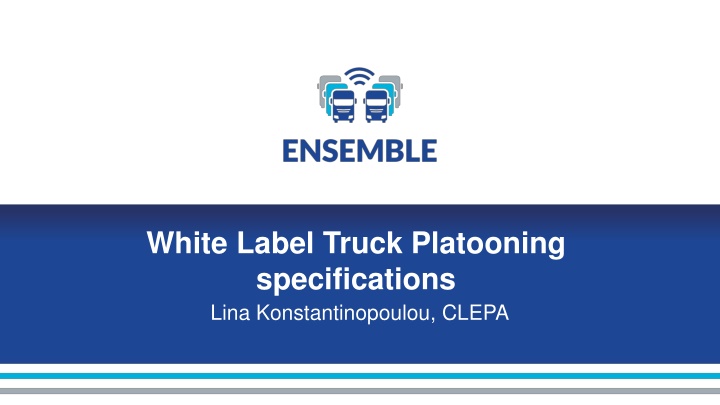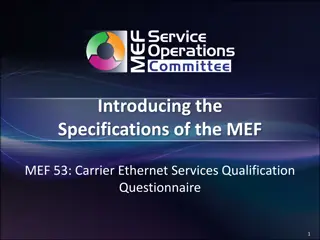Overview of White Label Truck Platooning Specifications
White Label Truck Platooning involves driving trucks at short inter-vehicle distances for extended periods, creating a system of interconnected systems with specific requirements. The driver cannot be solely responsible for immediate intervention during critical events, necessitating a unique automation level classification for heavy-duty vehicles in platooning applications. The ENSEMBLE project demonstrates Platoon level A and conducts research on B and C specifications, focusing on maximum truck numbers, time gap distances, longitudinal automation, safety functions, and more. Key use cases of platoon level A include platoon formation, engaging and merging vehicles, steady-state platooning, emergency braking, and system status updates. CLEPA plays a vital role as the WP2 leader in the ENSEMBLE project, focusing on specifying a generic solution for multi-brand truck platooning.
Download Presentation

Please find below an Image/Link to download the presentation.
The content on the website is provided AS IS for your information and personal use only. It may not be sold, licensed, or shared on other websites without obtaining consent from the author.If you encounter any issues during the download, it is possible that the publisher has removed the file from their server.
You are allowed to download the files provided on this website for personal or commercial use, subject to the condition that they are used lawfully. All files are the property of their respective owners.
The content on the website is provided AS IS for your information and personal use only. It may not be sold, licensed, or shared on other websites without obtaining consent from the author.
E N D
Presentation Transcript
White Label Truck Platooning specifications Lina Konstantinopoulou, CLEPA
Platooning levels and SAE Truck platooning, involves driving at short inter-vehicle distances for an extended period. The platoon as a whole can be seen as a system of interconnected systems with specific requirements. The driver cannot be held responsible for timely intervention in case of safety- critical events such as hard braking. Hence, the first three SAE automation levels are not directly applicable for the platooning application. Need arises to create a different automation level classification for heavy duty vehicles that considers the explained needs of Platooning. ENSEMBLE will demonstrate Platoon level A and research B and C specifications
Platoon level A Maximum number of trucks of 7 is considered for platoon level A in ENSEMBLE The time gap distance target between 0.8 and 1.4 s. (as close as possible to reach the benefits), Longitudinal automation with fail operation, not lateral automation This requires new longitudinal functions, e.g. Brake Performance Calculation and safety functions e.g. redundant braking functions, additional sensors New members of a running platoon can only join from the rear. The system is in control of the longitudinal functional safety of the vehicle Interaction with platooning services and infrastructure is technically available Note: the driver will remain legally responsible at all times such as adverse conditions like bad weather, slopes, etc (it is the drivers decision to activate platooning)
Platoon level A use cases The main high level use cases of platoon level A are: Platoon formation Platoon formation based on generic match making (Orchestrated non real-time) Platoon formation based on just extended awareness (Orchestrated real-time) Engaging to platoon Join from behind by single vehicle Merge from behind by existing platoon Platooning Steady state platooning Follow to stop (&go) Emergency braking (caused by AEB system or manual overrule) Platoon gap adaptation I2V interaction Cut-in (long time) Cut-in (short time) ( Cut-through ) System status (e.g. packet loss) Disengage platoon Leave Split
CLEPA s role in the ENSEMBLE project CLEPA is WP2 leader - WP2 Specification of a generic solution This WP will define the specification for the whole multi-brand truck platooning concept. Input for regulation and standardization























